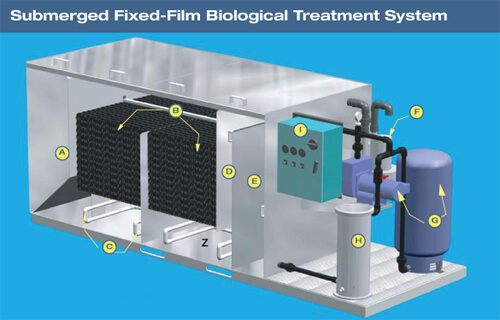Wash Water Recycling Systems
Industrial Wash Water Recycle Systems
Closed Loop Recycle System
Designed to handle washing industrial equipment or parts and can supply from one to six pressure washers. Wash Water Recycle Systems employ a biological remediation process. This term refers to the use of biological agents, such as bacteria or plants, to remove or neutralize contaminants, as in polluted soil or water. Users of this equipment will need to replenish the colonies of microbes.
This line of wash water recycle systems versatile and low maintenance and are extremely effective for applications such as:
Equipment rental yards, automotive recyclers, military fleet operations, fork lift dealerships, trucking, marinas, food processing plants, municipalities ,warehouses, and oil field services to name a few.
- Electrical Requirements: 230 Volt/ 1 Phase (40 Amps)
- Wash Water Flow Range: 0-15 GPM
- Pressure Pump: ¾ HP (Centrifugal)
- Regenerative Blower: 1.5 HP
- Biological Media: 1,152 sq ft for 750 Model; 2,679 sq ft for 850 Model. Biological Remediation process with 54 SCFM regenerated aeration.
- Construction: Marine Grade Aluminum
- Water Supply: 3/4 “ fresh water with valve for auto-fill
- Round In Ground Self Cleaning Sump: 30”x’32”x32”
- Solids Separator, Above Ground: 2FT’ x 4FT
- One Spare Cartridge Filter
- Warranty: One Year Parts and Labor
| MODEL | DESCRIPTION | DAILY CAPACITY | DIMENSIONS | WEIGHT | PRICE |
| WW-750 | Wash Water Recycling System | 1,250 gallons | 7' x 4' x 4' | 700 lbs |
|
| WW-850 | Wash Water Recycling System | 3,030 gallons | 10' x 5' x 5' | 1100 lbs |  for Pricing for Pricing |
| WW-TRN-1 | Installation/Training |
|
Please call for pricing on microbe replenishment pack. Ships UPS 2nd Day Air for preservation of colonies.
Installation and Service
With a talented service team that is second to none, Ultimate Washer can arrange the installation and service of your wash water recycling systems to maximize the operation and performance. Installation, Start Up and Training is necessary.

A- Solids Settling
Each system comes with an integral solids settling chamber at the beginning of the system. The coned-bottom settling chamber allows time for the heavy particles to settle out simplifying maintenance. A 2-inch valve is provided to periodically remove the collected solids.
B- Bio reactor
The bio reactors are equipped with over under weirs and bio-media that ensure maximum contact time with the microbes. The submerged, fixed film bio-media creates a large amount of surface area for the microbes to cling. Once the microbes are attached to the media, they can handle swings in contaminant loading, pH, temperature and other factors that limit the application of biological treatment systems. Microbes are continuously added to the system to ensure proper counts for the particular waste stream.
C- Aerators
The bio reactors are continuously fed with oxygen rich air through the aerators. The microbes require oxygen in order to consume the organic contaminants. The aerators are designed not to clog and to produce an air bubble that will allow for maximum oxygen transfer.
D- Clarifier
The biologically treated wastewater has to travel through the integral clarifier. The clarifier collects the floc particles created during the biological degradation process. These floc particles are then used as a food source for the microbes during low contaminant loading times.
E- Clean Water Well
The final step in the biological treatment process is the clean water well. The clean water well stores the treated wastewater for re-use or discharge.
F- Blower
The blower operates continuously to provide oxygen to the microbes in the bio reactor. The blower requires no maintenance and can run continuously for up to 20,000 hours.
G- Pressurization
In the recycling systems the treated wastewater is pressurized to up to 70 psi for re-use.
H- Cartridge Filter
A cartridge filter is provided to remove particles down to as low as 1 micron. The cartridge filters are made of a poly screen that can be easily washed out for long life expectancy.
I- Control Panel
The control panel is UL listed. All functions of the treatment system can be controlled from this panel. The system is designed to be totally automated. Only during routine maintenance should any of the controls need to be adjusted.








